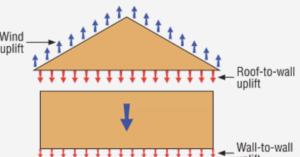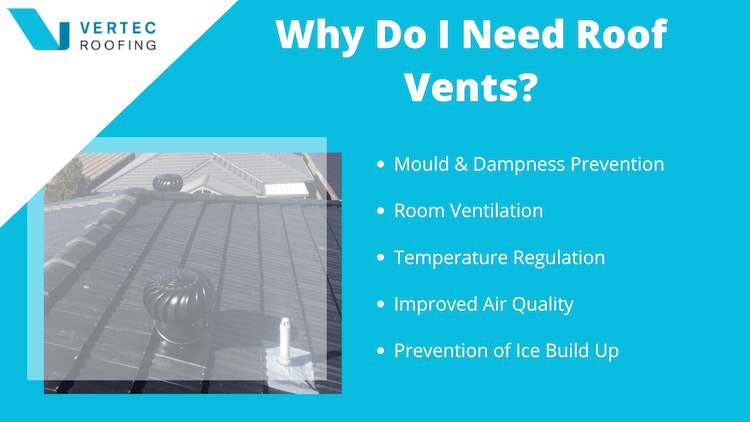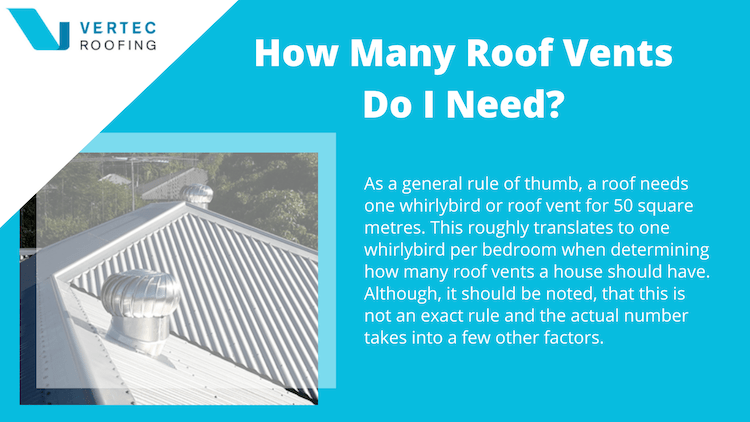

How many roof vents should I have? If you’re building or renovating a new house or commercial site, how many roof vents you should install are an important consideration.
In order to successfully answer the question of “how many roof vents should I have?”, we need to understand the function and purpose of a roof vent. Roof vents are required to maintain a healthy roofing system and work by keeping air constantly circulating throughout a roof cavity. They work by drawing in cool and fresh air into the roof to replace the hot a humid air that the roof collects, that is then expelled.
The most popular and efficient roof ventilation system used in Australia is the whirlybird or turbine vent. Whirlybirds are extremely versatile and can be used in a number of different ways and with a number of different roofing and ventilation systems. The most common use is highly efficient and works by using the wind to rotate vent, which creates a vacuum effect to suck hot air from the roof cavity and expel in out into the open.
However, whirlybirds can be used in a few other different ways; vents can be used and paired with other natural ventilation systems like ridge and soffit vents, which can bring up new questions like “how many soffit vents should I install?”. Whirlybirds can be combined with powered options for a greater impact and wholistic home cooling system. These types of vents are also completely waterproof; the force of the spinning motion is also great enough that any water will be expelled in the same fashion as they expel air.
So, why do you need roof vents? Well, there are several reasons you might choose or need to get a roof vent installed, and this will help in deciding the big question of, “how many roof vents should I have?”. Here are the main reasons for needing roof vents:

By preventing moisture build-up in the roof cavity with air circulation, roof vents stop the formation of mould and dampness that is common areas with little to no airflow.
Roof vents remove excess heat from roof cavities and help moderate the temperature of your home. This, in turn, will help you save on utility bills, like electricity, as you are less likely to use air conditioning or highly inefficient other cooling solutions.
Vents also help improve the air quality in your home; when stale air starts to circulate around your home it picks up dust particles and other pollutants that then spread further. Vents help to expel this air and replace it with fresh and clean air from outside the home.
In areas of extreme cold, which only applies to certain areas of Australia, having proper roof ventilation prevents the ice dams and icicles forming on and in the roof during winter. Thankfully, this isn’t something we necessarily need to worry about in Sydney!
As a general rule, a roof needs one whirlybird or roof vent for 50 square metres. This roughly translates to one whirlybird per bedroom when determining how many roof vents should a house have. Although, it should be noted, that this is not an exact rule and the actual number takes into a few other factors.
When asking “how many whirlybird vents do I need”? It is important to remember that not all whirlybirds are the same. Some whirlybirds (generally the ones that are greater in diameter) will move more air than others. A whirlybird with a diameter of 30cm and a wind speed of 8km per hour, will remove and replace almost 10 cubic meters of air per minute from your roof cavity. In comparison to one that has a diameter of 35cm and a wind speed of 25km per hour, where the whirlybird will move 38 cubic meters of air per minute. This is a pretty significant difference and knowing which one to use and when is something that requires a bit of math and some professional knowledge.
Similarly, some roofs may have closed off sections that collect heat and will require their own whirlybird or ventilation system. Now, the size of this sectioned off part of the roof might be quite small in comparison to the total square meterage of the roof and only require one smaller whirlybird.
Mould and dampness are common, especially for the older homes found in many suburbs around Australia. Older homes lack the proper ventilation needed to expel moisture and stop condensation forming, which is what mould needs to grow. Not only is mould damaging to the house but is also harmful to those that breath it in. Damp mould can cause coughing, sneezing, nasal congestion and respiratory infections. So, it is important to stop and hinder mould being produced in the home. The best way to do this is by increasing ventilation and airflow throughout your home. Now you might be asking yourself “how many roof turbines do I need to avoid mould build-up?”

If you are finding mould throughout your home or in specific areas of your home, you will need to consider how you’re going to increase airflow and ventilation. Roof ventilation will help the overall airflow and air quality in your home and is a great starting point. Often old homes have no roof vents so installing the appropriate amount whirlybirds should have quite an immediate impact. If the problem persists there maybe be an isolated issue or a waterproofing problem that may require additional work.
Not only do whirlybirds keep a roof healthy by expelling moisture and therefore stopping the build-up mould, but they are also a great way to make your home more energy efficient. The way they do this is quite simple, by moderating your roof temperature, whirlybirds are removing either cold or hot air from your roof, keeping your house cooler in summer and warmer in winter. This means the need for air conditioning or heating systems is reduced and leads to a smaller electricity bill at the end of the year.
Your roofing system and its size will again determine the number of whirlybirds needed. When asking “how many roof vents should I have?”, in terms of energy efficiency, a good place to start is by following the general rule of one whirlybird or roof vent for 50 square metres. This gives a good base for your homes energy efficiency, but in order to get the most out of your ventilation system, it’s best to seek some professional advice. A professional will have a better idea of what is needed and how each additional vent will add to the overall system. You can go even further and get a home energy audit that will help determine how effective your ventilation system is and give insights into whether it needs to be updated.
If you’re still asking the question, “How many roof vents should I have?”, get in contact with one of our experts today. At Vertec Roofing, we pride ourselves on our commitment to quality advice. While we offer our services at reasonable rates, we only provide accurate quotes and use the best quality roof whirlybirds. We complete whirlybird installation in Sydney on both metal and tiled roofs to ensure that your property is properly ventilated, energy-efficient and safe from mould and damp.
If you’d like to learn more about what whirlybird installation can do for you, get in touch with one of our experts today. Our roofing contractors are experienced, knowledgeable, and offer professional advice on your roofing project with a no-obligation quote.

At Vertec Roofing, we believe roofing is about protecting homes and enhancing comfort.